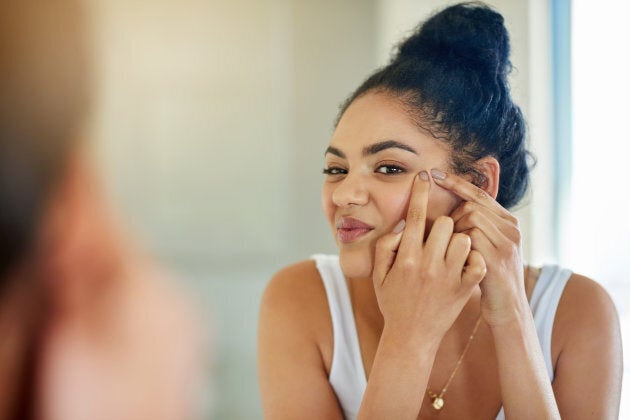Pimple popping is bad for you and should be avoided at all costs. This is a message we've all been told time and time again, though whether we listen to it once a nasty whitehead comes along is another story.
But if squeezing your pimples is really that bad, then why do facial extractions exist? And why hasn't anyone stopped Dr Pimple Popper from terrorising treating her patients?
The fact of the matter is, when it comes to pimple popping, it's not all bad... though it's definitely best to leave it to the experts.
"When you talk about pimple popping, often times we dermatologists think of a dimly lit bathroom with yucky fingernails and just pus exploding everywhere," dermatologist and spokesperson for the Australian College of Dermatologists, Dr Jo-Ann See, tells HuffPost Australia.
"But it's a little bit different if you actually you know about pimples and how to extract them.
"In a controlled manner it's actually okay, and lots of professional dermatologists do it."
Dr. Sandra Lee (aka Dr Pimple Popper) is famous for posting videos like this one. Watch at your own risk.
For one, an expert is far more likely to have the right equipment to perform successful extractions without causing too much distress to your skin.
"There are a lot of different ways [to treat acne] but certainly with extraction, if you do it properly you do it with a comedone extractor," See says. "That's what I use.
"That's your blackhead and whitehead remover and you just pierce the surface of the skin and put that device on and the pimple pops out.
"You're not giving a huge squeeze where you are rupturing the follicle."
When you pop, you press down on the skin and you will get a scar.Dr Jo-Ann See
This is essentially why dermatologists (and your mum) are so against you taking matters into your own hands -- because while pimple extraction isn't necessarily a bad thing, if you do it yourself, the chances are you will do more harm than good.
"When you squeeze it in the privacy of your own bathroom, you go side to side, don't you," See says. "The downside to this is rupturing the follicle and getting scarring. That's the major risk.
"When you pop, you press down on the skin and you will get a scar.
"Also, sometimes when you pop a pimple, you don't realise it's not just one simple pimple, it's a few joined up. So it reforms."

It's also important to note not all pimples are created equal, so even if you bought your own comedone extractor, you might not be using it correctly. And as satisfying as a good pimple squeeze might be, it might not actually be the right kind of treatment in the first place.
"When it comes to acne treatment, it really depends on the person," See says. "Ideally when you are getting treatment, you want the person's acne to clear. But there are many different ways to get to that end goal.
"For instance there are lots of prescription products that are really good getting rid of blackheads and whiteheads. But some can be stubborn, and in that case, it's reasonable to remove them.
"For a really big pimple, a dermatologist may choose to inject a little bit of steroid in and it just melts away instantly. That provides great instant relief from those deep hormonal ones."
If you do it yourself and you make it worse than it was before, you're actually rupturing the skin.
At the end of the day, it really is best to leave your face alone, or at the very least book in to see an expert so they can treat you properly.
"While there can be a little bit of irritation when you get done professionally, it's nothing compared to what could happen if you did it yourself," See says.
"At the very least, you're lying down, [the expert] has better access, better equipment, better knowledge.
"If you do it yourself and you make it worse than it was before, you're actually rupturing the skin. And that's even worse if you have darker skin, much worse.
"I'm talking skin types four, five, six -- so your Lebanese, Asian, Indian skin types. When you squeeze, you often get left with post-inflammatory hyper pigmentation and that leaves a dark brown mark."
Click below to subscribe to the Refresh podcast by HuffPost Australia on iTunes.

ALSO ON HUFFPOST AUSTRALIA